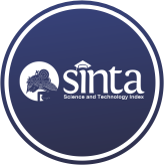Data Mining untuk Memprediksi Animo Masyarakat terhadap Proses Penerimaan Peserta Didik Baru
(1) Universitas Bina Nusantara, Jakarta, Indonesia
(2) Universitas Bina Nusantara, Jakarta, Indonesia
(*) Corresponding Author
Abstract
Data Mining techniques can now be implemented in all aspects of society because of development in technology. Data Mining can be used in education. There is the possibility of being employed for educational purposes to predict achievements. The involvement of the community is one of the factors that influence the quantity of students at the school. The research project is using Data Mining to predict the factors that impact social engagement. The demographic information used in this study came from the parents of potential candidates. The techniques used are Decision tree, Naïve bayes, and Support Vector Machine. Their accuracy scores are evaluated by a confusion matrix. The results of this study are below: Decision tree 80.16%, Naïve Baye 79.94%, and Support Vector Machine 86.02%. Based on the comparison results, it can be concluded that the highest accuracy is achieved by using the Support Vector Machine algorithm, while the factor that affects public sentiment is ayah penghasilan.
Full Text:
PDFReferences
A. Maritsa, U. Hanifah Salsabila, M. Wafiq, P. Rahma Anindya, And M. Azhar Ma’shum, “Pengaruh Teknologi Dalam Dunia Pendidikan,” Al-Mutharahah: Jurnal Penelitian Dan Kajian Sosial Keagamaan, Vol. 18, No. 2, Pp. 91–100, Dec. 2021, Doi: 10.46781/Al-Mutharahah. V18i2.303.
M. Mahaputra Hidayat, P R O S I D I N G S N A T I F K E-2 T A H U N 2 0 1 5 Educational Data Mining Untuk Meningkatkan Pendukung Keputusan Dalam Sistem Informasi Sekolah.
W. Istriyani And M. D. Satyarini, “Manajemen Penerimaan Peserta Didik Baru Di Smk Sultan Trenggono Gunungpati Semarang,” Journal Of Economic Education And Entrepreneurship, Vol. 2, No. 1, P. 38, Jul. 2021, Doi: 10.31331/Jeee. V2i1.1677.
J. Ma’sum, A. Febriani, And D. Rachmawaty, “Penerapan Metode Klasifikasi Decision Tree Untuk Memprediksi Kelulusan Tepat Waktu,” Journal Of Industrial Engineering And Technology (Jointech) Universitas Muria Kudus Journal Homepage, Vol. 2, No. 1, Pp. 1–14, 2021, [Online]. Available: Http://Journal.Umk.Ac.Id/Index.Php/Jointech
S. Tuaha, I. F. Siddiqui, And Q. Ali Arain, “Analyzing Students’ Academic Performance Through Educational Data Mining,” 3c Tecnología_Glosas De Innovación Aplicadas A La Pyme, Pp. 402–421, May 2019, Doi: 10.17993/3ctecno.2019.Specialissue2.402-421.
A. H. Sani, A. Setiawan, And A. Primadewi, “Penerapan Metode Naive Bayes Dalam Rekomendasi Strategi Penerimaan Peserta Didik Baru,” Journal Of Computer System And Informatics (Josyc), Vol. 4, No. 1, Pp. 245–251, Dec. 2022, Doi: 10.47065/Josyc. V4i1.2438.
A. Ashari Muin, “Metode Naive Bayes Untuk Prediksi Kelulusan (Studi Kasus: Data Mahasiswa Baru Perguruan Tinggi),” Jurnal Ilmiah Ilmu Komputer, Vol. 2, No. 1, 2016, [Online]. Available: Http://Ejournal.Fikom-Unasman.Ac.Id
S. Kumar And S. Kumar Yadav, “: A Prediction For Performance Improvement Of Engineeringstudents Using Classification Data Mining: A Prediction For Performance Improvement Of Engineering Students Using Classification Saurabh Pal,” 2012. [Online]. Available: Https://Www.Researchgate.Net/Publication/221710771
J. Han, M. Kamber, And J. Pei, “Data Mining. Concepts And Techniques, 3rd Edition (The Morgan Kaufmann Series In Data Management Systems),”
(Ncr And J. Clinton, “Crisp-Dm 1.0 Step-By-Step Data Mining Guide,” Daimlerchrysler, 1999.
T. Wurijanto, H. B. Setiawan, And A. B. Tjandrarini, “Penerapan Model Crisp-Dm Pada Prediksi Nasabah Kredit Yang Berisiko Menggunakan Algoritma Support Vector Machine,” Jurnal Ilmiah Scroll: Jendela Teknologi Informasi, Vol. 10, No. 1, 2022, [Online]. Available: Https://Univ45sby.Ac.Id/Ejournal/Index.Php/Informatika
DOI: https://doi.org/10.30645/kesatria.v6i1.563
DOI (PDF): https://doi.org/10.30645/kesatria.v6i1.563.g558
Refbacks
- There are currently no refbacks.
Published Papers Indexed/Abstracted By:














